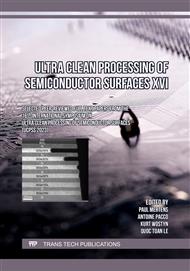p.311
p.318
p.325
p.331
p.335
p.341
p.346
p.351
p.356
A Cleaning Method for Post-Etch Ruthenium Residue Removal Using UV and Liquid Chemical
Abstract:
As semiconductor devices continue to scale, it is important to evaluate alternative metals on narrower wiring or via structures. Ruthenium (Ru) is one promising candidate because of its lower resistivity compared to the conventional metals such as copper (Cu), cobalt (Co) and tungsten (W) on narrow space. To prevent leakage problems between metal layers caused by residues on the bottom and sidewalls after the metal patterning process, a cleaning process for Ru metal lines is necessary. Although the industry standard using Ammonia Peroxide Mixture (APM) is effective for removing residues, it was ineffective for Ru semi-damascene stack. Therefore, a new cleaning method involving UV treatment followed by APM, which was tested on metal pitch 18 nm patterned structure, was developed. This method showed promising results and is expected to be used in manufacturing of future semiconductor devices.
Info:
Periodical:
Pages:
335-340
Citation:
Online since:
August 2023
Keywords:
Price:
Сopyright:
© 2023 Trans Tech Publications Ltd. All Rights Reserved
Share:
Citation:


